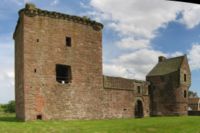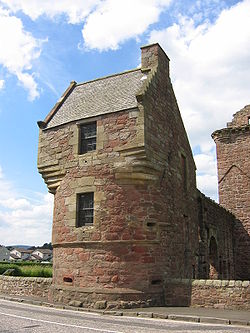
Burleigh Castle
Encyclopedia

Milnathort
Milnathort is a small village in the Perth & Kinross region of central Scotland.The smaller neighbour of nearby Kinross, Milnathort has a small population of roughly 1000 people. It is situated amidst picturesque countryside at the foot of the Ochil Hills, and near the north shore of Loch Leven...
, 1.5 miles north of Kinross
Kinross
Kinross is a burgh in Perth and Kinross, Scotland. It was formerly the county town of Kinross-shire.Kinross is a fairly small town, with some attractive buildings...
, in Perth and Kinross
Perth and Kinross
Perth and Kinross is one of 32 council areas in Scotland, and a Lieutenancy Area. It borders onto the Aberdeenshire, Angus, Dundee City, Fife, Clackmannanshire, Stirling, Argyll and Bute and Highland council areas. Perth is the administrative centre...
, Scotland
Scotland
Scotland is a country that is part of the United Kingdom. Occupying the northern third of the island of Great Britain, it shares a border with England to the south and is bounded by the North Sea to the east, the Atlantic Ocean to the north and west, and the North Channel and Irish Sea to the...
. The castle dates from the 15th and 16th centuries, and now sits beside the A911 road, opposite a 19th century steading, recently adapted into housing.
History
The lands of Burleigh were held by the Balfours from 1446, when they were granted by James IIJames II of Scotland
James II reigned as King of Scots from 1437 to his death.He was the son of James I, King of Scots, and Joan Beaufort...
to John Balfour of Balgarvie, and a tower house was erected in the late 15th or early 16th century. Sir James Balfour of Pittendreich
James Balfour of Pittendreich
James Balfour, Lord Pittendreich was a Scottish judge and politician.The son of Sir Michael Balfour of Montquhanny, he was educated for the legal branch of the Church of Scotland...
extended the castle in the late 16th century, adding a curtain wall with a corner tower, and other outbuildings. In 1607 his son Sir Michael Balfour was raised to the peerage
Peerage
The Peerage is a legal system of largely hereditary titles in the United Kingdom, which constitute the ranks of British nobility and is part of the British honours system...
as Lord Balfour of Burleigh
Lord Balfour of Burleigh
Lord Balfour of Burleigh, in the County of Kinross, is a title in the Peerage of Scotland. It was created in 1607 for Sir Michael Balfour. He was succeeded by his daughter Margaret, the second holder of the title. She married Robert Arnot, who assumed the surname of Balfour in lieu of Arnot, and...
.
Legend tells how Robert Balfour
Robert Balfour, 5th Lord Balfour of Burleigh
Robert Balfour, 5th Lord Balfour of Burleigh , was a Jacobite.Balfour, when a youth fell in love with a 'pretty face,' far inferior in rank, much to the annoyance of the family. He was sent to travel abroad in the hope that he would forget his attachment. Before he set out he declared to his...
, before his accession as 5th Lord, narrowly escaped death when, in 1707, he was sentenced to beheading for the murder of the schoolmaster of Inverkeithing
Inverkeithing
Inverkeithing is a town and a royal burgh in Fife, Scotland, located on the Firth of Forth. According to population estimates , the town has a population of 5,265. The port town was given burgh status by King David I of Scotland in the 12th century and is situated about 9 miles north from...
, who had the misfortune to have married Balfour's childhood sweetheart. Escaping from Edinburgh tolbooth, Balfour joined the Jacobite
Jacobitism
Jacobitism was the political movement in Britain dedicated to the restoration of the Stuart kings to the thrones of England, Scotland, later the Kingdom of Great Britain, and the Kingdom of Ireland...
cause, proclaiming the 'Old Pretender' James Stuart
James Francis Edward Stuart
James Francis Edward, Prince of Wales was the son of the deposed James II of England...
king at Lochmaben
Lochmaben
Lochmaben is a small town in Scotland, and site of a once-important castle. It lies four miles west of Lockerbie, in Dumfries and Galloway.-Notable people:*Angus Douglas - Scottish internationalist footballer...
, and fighting in the 1715 rising. Following the defeat of the Jacobites, Balfour was attainted, dying in France in 1757.
The castle was forfeit to the Irwins, then passed to the Grahams of Kinross. It is now a Scheduled Ancient Monument
Scheduled Ancient Monument
In the United Kingdom, a scheduled monument is a 'nationally important' archaeological site or historic building, given protection against unauthorized change. The various pieces of legislation used for legally protecting heritage assets from damage and destruction are grouped under the term...
in the care of Historic Scotland
Historic Scotland
Historic Scotland is an executive agency of the Scottish Government, responsible for historic monuments in Scotland.-Role:As its website states:...
(no entrance charge; key available from nearby house at all reasonable times).
The castle

Tower house
A tower house is a particular type of stone structure, built for defensive purposes as well as habitation.-History:Tower houses began to appear in the Middle Ages, especially in mountain or limited access areas, in order to command and defend strategic points with reduced forces...
survives largely intact (though one of the first floor windows has been greatly enlarged) to three storeys and a garret in height. The 5 feet (1.5 m) walls rise to corbel
Corbel
In architecture a corbel is a piece of stone jutting out of a wall to carry any superincumbent weight. A piece of timber projecting in the same way was called a "tassel" or a "bragger". The technique of corbelling, where rows of corbels deeply keyed inside a wall support a projecting wall or...
s which once supported a parapet walk. The roof and internal floors are now gone, although the vaulted basement remains. The turnpike stair in the north-east corner originally led up to a caphouse giving access to the parapet walk.
To the south-west is a 16th century corner tower, two storeys high above a basement, which retains its roof. The tower is round at the base, and corbelled out to a square upper storey, and is a particularly fine and picturesque example of Scottish baronial architecture of the period. Its masonry is happily very well-preserved. Both this tower and the keep have gun loops around the base to deter attackers. The corner tower also has small round pistol-holes at cap-house level, though these may have been included more for their decorative effect than to provide a true defensive capability. Engraved on the north gable is the date 1582, and the initials SIB and MB, for Sir James Balfour and his wife Margaret. The two towers are connected by a section of curtain wall pierced by an arched gate. Though now only a 'skin' of masonry, this wall once fronted a two-storey gatehouse. With its string-course, hood-mould over the gateway and moulded surround formerly containing a heraldic panel, this wall is an excellent example of small-scale but refined architectural sophistication of its period in Scotland (probably contemporary with the round corner tower). A defensive moat may have surrounded the barmkin in the past.

